How to Make Jarred Tomato Sauce Better…And If You Even Should
Just because a sauce is pre-made doesn't mean it's finished.
Pasta and convenience: two things that tend to be naturally aligned. It'd be impossible to even guess at how many times we've relied on a quick-cooking bowl of spaghetti or rigatoni to fill our bellies in minimal time and with minimal effort. And while there are thousands of from-scratch pasta recipes that can be whipped up in minutes (aglio e olio, anyone?), there's no doubt that a jar of good premade tomato sauce is the quickest of quick. But can you make jarred products better, and is it even worth the effort?
Well, no...and yes. The truth is that once you start down the road of doctoring store-bought pasta sauce, you're adding enough effort that in many cases you might as well just whip up a quick-and-easy sauce from scratch. Is it really easier or better to spike a jarred sauce with fresh garlic or herbs, if you can make an equally wonderful sauce by, say, gently browning garlic and dried oregano in some olive oil and then briefly simmering some high-quality canned tomatoes with it? Frequently it is not.
But for all the instances in which it'd make just as much sense to forgo a supermarket brand of premade sauce, there are still times when you might enjoy popping the top off a ready-to-eat sauce and modify it in one way or another. There are few absolutes in life.
By applying at least one—if not a combination—of any of the tips below, you can customize store-bought tomato sauces to your heart's content, to satisfy whatever your pasta goals may be.
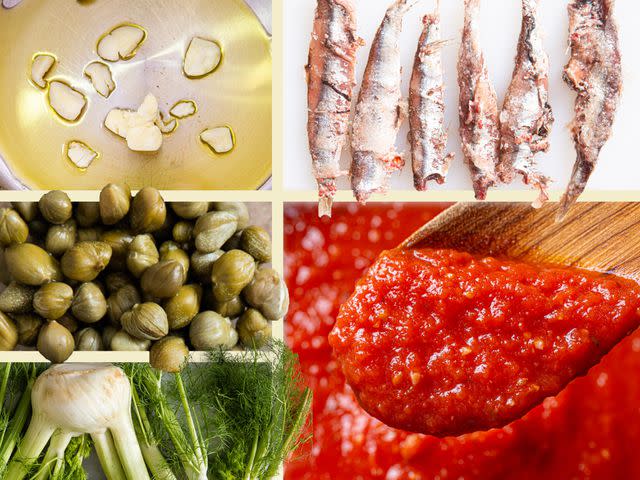
Serious Eats / Vicky Wasik
Start With a Good Jar
The best way to make a jarred sauce taste more like a good homemade one is to start with a high-quality product. Trying to save an overly sweet, out of balance jarred sauce is a waste of time when the market is now chock full of products that taste great from the moment you pop open the lid. Rao’s, for one, is a longstanding SE staff favorite in need of little improvement. The sauce is bright and fruity, with a balanced acidity and the pleasing flavors of garlic, olive oil, onion, basil, and oregano. And these days it's just one of many.
Add Alliums
You can treat a jarred sauce the same as a homemade sauce by sautéing classic alliums like garlic and/or onions in olive oil or butter before adding the sauce. In most cases, the jarred sauces will already have these ingredients cooked into them, but doubling down on garlic and onion is unlikely to elicit any complaints.
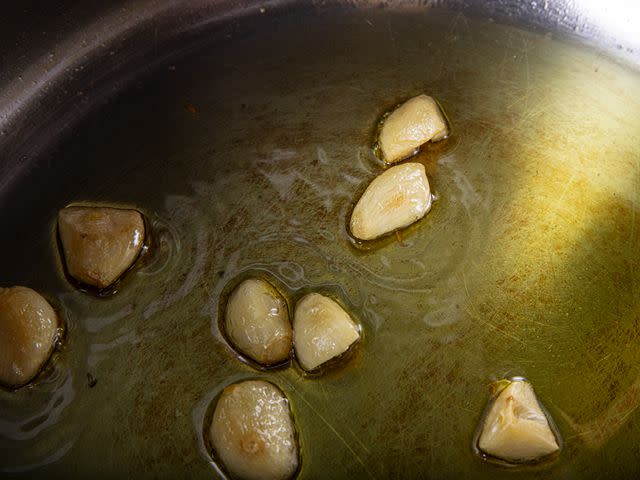
Amanda Suarez / Serious Eats
Deglaze With Wine
If you have a bottle of dry red or white kicking around, there's no harm in adding a splash to the pan after sautéing the above alliums in fat. Make sure to simmer the wine long enough to cook off its raw alcohol flavor before dumping the sauce into the pot, or you may end up with an unpleasantly boozy pasta.
Season With Fresh or Dried Herbs and Spices
While most jarred pasta sauces already contain some degree of seasonings like dried oregano and basil, a boost of these ingredients in a fresher form can enliven a sauce. A generous sprig or two of fresh herbs like basil, parsley, rosemary, or sage can all amp up the flavor of a jarred pasta sauce. Alternatively, some of those herbs, like parsley, sage, and rosemary, can be great minced up and gently fried into fresh olive oil before adding the sauce to the pot.
Keep in mind that when you add the fresh herbs will depend on the herb and the flavor you want. Simmered for longer, delicate herbs like basil and parsley lose some of their freshness in exchange for a deeper infusion, whereas adding them towards the end of cooking or off the heat keeps things lighter and brighter. Woodsy herbs like rosemary, meanwhile, require some simmering time to extract their flavor compounds, but if left too long (or used in too great a quantity) can end up making the sauce unpleasantly piney or menthol-y.
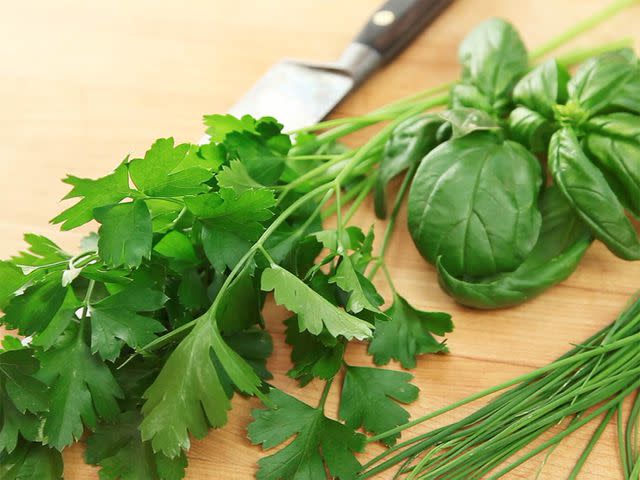
Dried herbs are another great option, especially if you want to go for a more classic Italian-American marinara vibe. Generally speaking, woodsier dried herbs like oregano are preferable to dried delicate herbs like basil, the latter of which lose almost all of their flavor once dried. And because many dried herbs like oregano have fat-soluble flavor compounds, you'll get more benefit out of blooming them in oil or butter before adding the sauce. That said, take care with how much you add, especially since jarred sauces usually start off with some level of herbal flavoring: It's better to start with a small pinch and then adjust to taste as needed, since it’s always easier to add flavor than take away.
Putting herbs aside, there are ingredients in your spice cabinet can also make a good addition to a tomato sauce. Toasted and ground fennel seeds, for example, can deepen a sauce's intensity and offer a suggestion of Italian sausage without actually adding any meat (as with the dried herbs, most spices will bring more flavor to the sauce if you toast them in oil or butter first, though this does add marginally more time and effort compared to just stirring the spices into the sauce and simmering for a few minutes).
Whisk in Tomato Paste
To double down on tomato flavor in your sauce, heat up a spoonful or two of tomato paste in a couple tablespoons of oil until softened and caramelized before pouring in the sauce and whisking to combine. Since tomato paste is heavily reduced and has such a concentrated tomato flavor, it’s a quick way to make a sauce taste like it's been simmering for hours without actually having to do so.
Boost the Acidity
Tomatoes are naturally acidic, but sometimes a jarred pasta sauce can lean too sweet, or just taste flat. Incorporating acids like lemon juice (and even zest) or red wine vinegar right before serving can round out your sauce. Added acidity also balances the sweetness often found in many lower-quality jarred tomato sauces, but again, why buy those?
Toss in Olives or Capers
Briny ingredients like olives or capers are another way to brighten up your pasta sauce while also introducing texture and depth of flavor. Roughly chop a handful and stir them into your sauce while it’s heating up on the stove. If you go heavy on some of these ingredients, you can bend a store-bought sauce in the direction of a puttanesca, one classic sauce that can be hard to find on store shelves.

Add Vegetables
Sautéing an array of aromatic vegetables in olive oil before adding your sauce can boost flavor while also creating more texture. A "battuto" (the Italian term for a finely minced mirepoix of onions, celery, and carrots) is a great place to start, but you can also try sautéed mushrooms, which will add a dose of umami, or fresh fennel, which will add complexity.
Get Meaty
A variety of meats can work to infuse fat, flavor, and texture to a jarred sauce. The best meats for this are fatty cuts with big flavor that will turn tender in a short simmer—think Italian sausage, pancetta, ground meats (like beef, pork, or lamb), and even bacon. Brown your preferred meat (or a combination) in a pan with olive oil to render its fat, then add your sauce and simmer until the meat is tender and fully cooked. Even as little as two ounces of meat will add considerable flavor. This is a great way to add richness and protein to your sauce, turning it into a more filling meal.
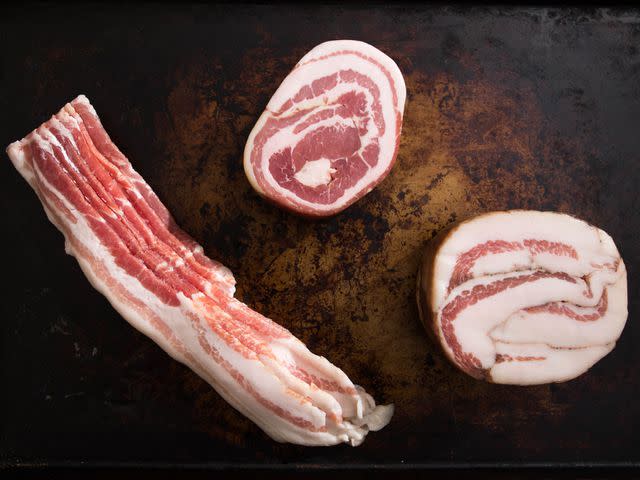
Amp Up the Umami
Incorporating umami-rich ingredients into a jarred pasta sauce can increase complexity and savoriness. In addition to umami-rich ingredients like mushrooms and grated cheese mentioned in other sections here, you can melt a couple anchovy fillets in some olive oil before adding the sauce, or dissolve in a bouillon cube, a spoonful of miso, or a splash of fish sauce or Worcestershire sauce. Just be careful you don't go overboard by using too much or too many of these intensely flavored ingredients.
Enrich With Dairy or Olive Oil
Just because a sauce is pre-made doesn't mean it's finished. Just as we like to simmer pasta in its sauce with a little bit of the pasta-cooking water for the last few minutes of cooking, we also like to enrich most sauces with a final glug of fresh olive oil, a pat of butter, and/or a big handful of finely grated cheese like Parmigiano-Reggiano or Pecorino Romano. Vigorously stirred into the sauce off the heat, these ingredients thicken the sauce for a more silky texture and round out any lingering tangy notes from the tomato sauce.
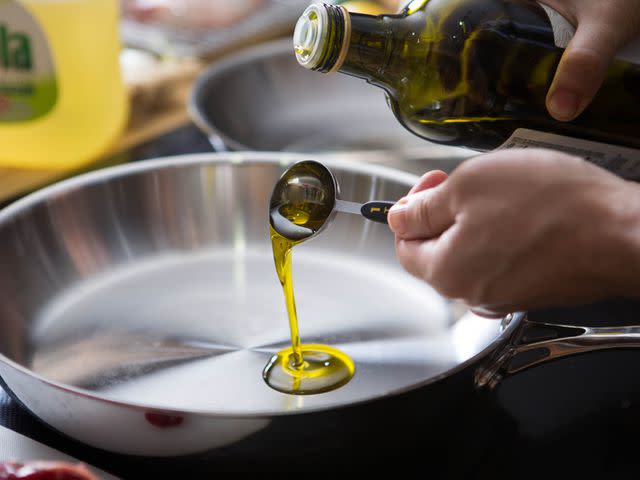
On a related note, if you have some old grated-cheese rinds awaiting a purpose, you can also toss one of them into the sauce to make use of their flavor (though this will require a longer simmer that arguably defeats the purpose of a jarred-sauce convenience hack).
Beyond those basics, you can in some instances enhance a sauce with a splash of cream or half and half, a dollop of ricotta or some mascarpone. These can transform a sauce into something more like a creamy vodka, but please be thoughtful about what kind of jarred pasta sauce you're starting with. The sweetness of cream, ricotta, and mascarpone all blend more seamlessly with a sauce that has a similar flavor profile—more fruity and sweet than acidic and herbal. That's not to say a classic oregano-tinged marinara can't be mixed with creamy dairy, just that not all sauces are good fits for that kind of fat.
Kick Up the Heat
Sometimes all it takes is a little spice to amp up a pasta sauce’s flavor. Try sprinkling in some red pepper flakes or stirring in some Calabrian chile paste for a welcome kick, though as noted with some of the other ideas above, these ingredients tend to incorporate most seamlessly into a sauce if heated in oil first, which will add time to the process.
Read the original article on Serious Eats.

